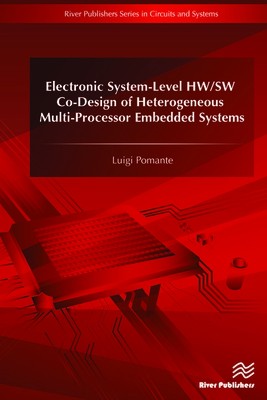
- We will send in 10–14 business days.
- Author: Luigi Pomante
- Publisher: River Publishers
- Year: 2016
- Pages: 270
- ISBN-10: 8793379382
- ISBN-13: 9788793379381
- Format: 15.6 x 23.4 x 1.6 cm, hardcover
- Language: English
- SAVE -10% with code: EXTRA
Electronic System-Level Hw/SW Co-Design of Heterogeneous Multi-Processor Embedded Systems (e-book) (used book) | bookbook.eu
Reviews
Description
Modern electronic systems consist of a fairly heterogeneous set of components. Today, a single system can be constituted by a hardware platform, frequently composed of a mix of analog and digital components, and by several software application layers. The hardware can include several heterogeneous microprocessors (e.g. GPP, DSP, GPU, etc.), dedicated ICs (ASICs and/or FPGAs), memories, a set of local connections between the system components, and some interfaces between the system and the environment (sensors, actuators, etc.). Therefore, on the one hand, multi-processor embedded systems are capable of meeting the demand of processing power and flexibility of complex applications. On the other hand, such systems are very complex to design and optimize, so that the design methodology plays a major role in determining the success of the products. For these reasons, to cope with the increasing system complexity, the approaches typically used today are oriented towards co-design methodologies working at the higher levels of abstraction. Unfortunately, such methodologies are typically customized for the specific application, suffer of a lack of generality and still need a considerable effort when real-size project are envisioned. Therefore, there is still the need for a general methodology able to support the designer during the high-level steps of a co-design flow, enabling an effective design space exploration before tackling the low-level steps and thus committing to the final technology. This should prevent costly redesign loops.In such a context, the work described in this book, composed of two parts, aims at providing models, methodologies and tools to support each step of the co-design flow of embedded systems implemented by exploiting heterogeneous multi-processor architectures mapped on distributed systems, as well as fully integrated onto a single chip.
EXTRA 10 % discount with code: EXTRA
The promotion ends in 20d.15:32:48
The discount code is valid when purchasing from 10 €. Discounts do not stack.
- Author: Luigi Pomante
- Publisher: River Publishers
- Year: 2016
- Pages: 270
- ISBN-10: 8793379382
- ISBN-13: 9788793379381
- Format: 15.6 x 23.4 x 1.6 cm, hardcover
- Language: English English
Modern electronic systems consist of a fairly heterogeneous set of components. Today, a single system can be constituted by a hardware platform, frequently composed of a mix of analog and digital components, and by several software application layers. The hardware can include several heterogeneous microprocessors (e.g. GPP, DSP, GPU, etc.), dedicated ICs (ASICs and/or FPGAs), memories, a set of local connections between the system components, and some interfaces between the system and the environment (sensors, actuators, etc.). Therefore, on the one hand, multi-processor embedded systems are capable of meeting the demand of processing power and flexibility of complex applications. On the other hand, such systems are very complex to design and optimize, so that the design methodology plays a major role in determining the success of the products. For these reasons, to cope with the increasing system complexity, the approaches typically used today are oriented towards co-design methodologies working at the higher levels of abstraction. Unfortunately, such methodologies are typically customized for the specific application, suffer of a lack of generality and still need a considerable effort when real-size project are envisioned. Therefore, there is still the need for a general methodology able to support the designer during the high-level steps of a co-design flow, enabling an effective design space exploration before tackling the low-level steps and thus committing to the final technology. This should prevent costly redesign loops.In such a context, the work described in this book, composed of two parts, aims at providing models, methodologies and tools to support each step of the co-design flow of embedded systems implemented by exploiting heterogeneous multi-processor architectures mapped on distributed systems, as well as fully integrated onto a single chip.


Reviews